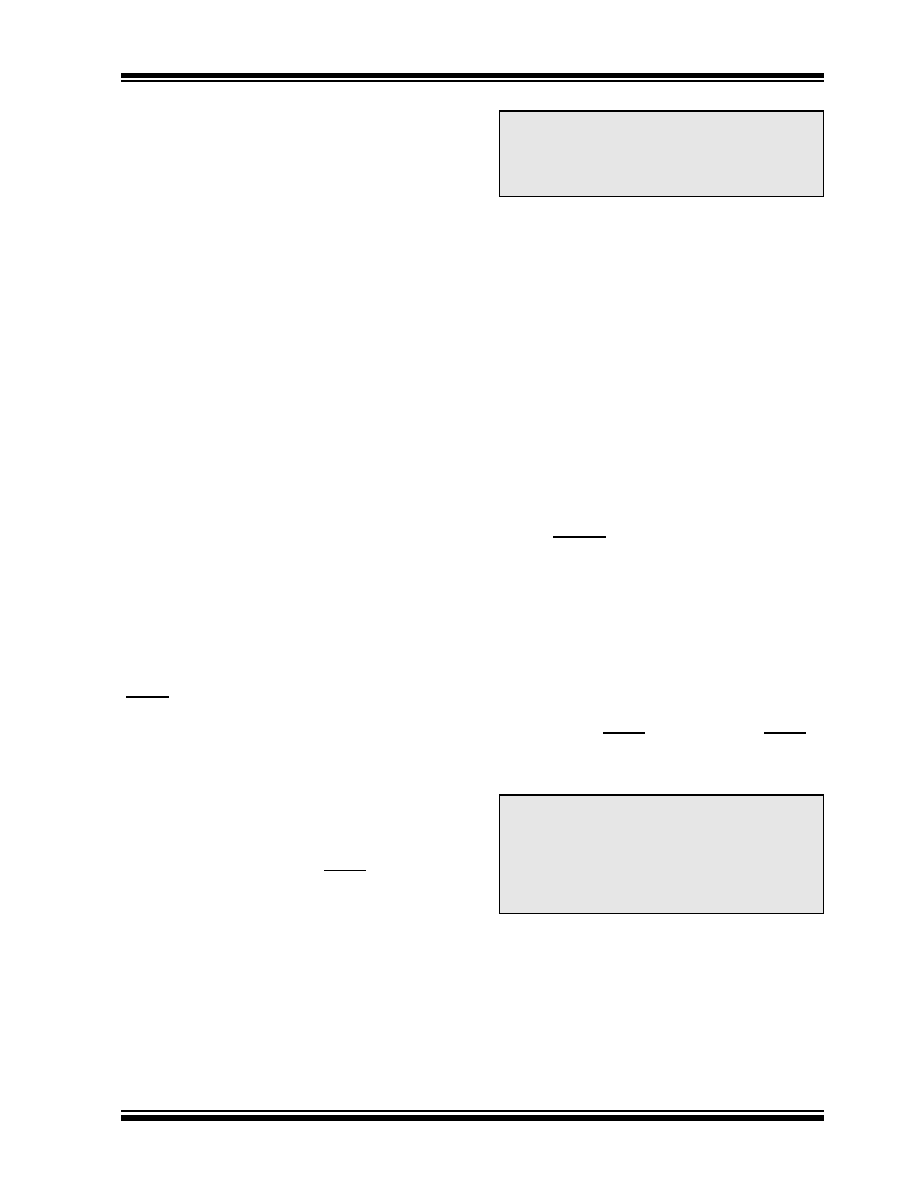- 您現(xiàn)在的位置:買賣IC網(wǎng) > PDF目錄98170 > TC647VUATR BRUSHLESS DC MOTOR CONTROLLER, PDSO8 PDF資料下載
參數(shù)資料
| 型號(hào): | TC647VUATR |
| 元件分類: | 運(yùn)動(dòng)控制電子 |
| 英文描述: | BRUSHLESS DC MOTOR CONTROLLER, PDSO8 |
| 封裝: | PLASTIC, MSOP-8 |
| 文件頁數(shù): | 24/28頁 |
| 文件大小: | 478K |
| 代理商: | TC647VUATR |
第1頁第2頁第3頁第4頁第5頁第6頁第7頁第8頁第9頁第10頁第11頁第12頁第13頁第14頁第15頁第16頁第17頁第18頁第19頁第20頁第21頁第22頁第23頁當(dāng)前第24頁第25頁第26頁第27頁第28頁

2002 Microchip Technology Inc.
DS21447C-page 5
TC647
3.0
DETAILED DESCRIPTION
3.1
PWM
The PWM circuit consists of a ramp generator and
threshold detector. The frequency of the PWM is deter-
mined by the value of the capacitor connected to the CF
input. A frequency of 30 Hz is recommended
(CF = 1 F). The PWM is also the time base for the
Start-up Timer (see Section 3.3, “Start-Up Timer”). The
PWM voltage control range is 1.25V to 2.65V (typical)
for 0% to 100% output duty cycle.
3.2
VOUT Output
The VOUT pin is designed to drive a low cost transistor
or MOSFET as the low side power switching element in
the system. Various examples of driver circuits will be
shown throughout this data sheet. This output has an
asymmetric complimentary drive and is optimized for
driving NPN transistors or N-channel MOSFETs. Since
the system relies on PWM rather than linear control,
the power dissipation in the power switch is kept to a
minimum. Generally, very small devices (TO-92 or SOT
packages) will suffice.
3.3
Start-Up Timer
To ensure reliable fan start-up, the Start-up Timer turns
the VOUT output on for 32 cycles of the PWM whenever
the fan is started from the off state. This occurs at
power up and when coming out of shutdown mode. If
the PWM frequency is 30 Hz (CF = 1 F), the resulting
start-up time will be approximately one second. If a
fault is detected, the Diagnostic Timer is triggered
once, followed by the Start-up Timer. If the fault
persists, the device is shut down (see Section 3.6,
“FAULT Output”).
3.4
Shutdown Control (Optional)
If VMIN (Pin 3) is pulled below VSHDN, the TC647 will go
into shutdown mode. This can be accomplished by
external transistor, as shown in Figure 3-1. All functions
are suspended until the voltage on VMIN becomes
higher than VREL (0.85V @ VDD = 5.0V). Pulling VMIN
below VSHDN will always result in complete device
shutdown
and
reset.
The
FAULT
output
is
unconditionally inactive in shutdown mode.
A small amount of hysteresis, typically one percent of
VDD (50 mV at VDD = 5.0V), is designed into the VSHDN/
VREL in Section 1.0, “Electrical Characteristics”,
include this hysteresis plus adequate margin to
account for normal variations in the absolute value of
the threshold and hysteresis.
3.5
SENSE Input
(FanSense Technology)
The SENSE input (Pin 5) is connected to a low value
current sensing resistor in the ground return leg of the
fan circuit. During normal fan operation, commutation
occurs as each pole of the fan is energized. This
causes brief interruptions in the fan current, seen as
pulses across the sense resistor. If the device is not in
shutdown mode, and pulses are not appearing at the
SENSE input, a fault exists.
The short, rapid change in fan current (high dI/dt)
causes a corresponding dV/dt across the sense
resistor, RSENSE. The waveform on RSENSE is
differentiated and converted to a logic-level, pulse-train
by CSENSE and the internal signal processing circuitry.
The presence and frequency of this pulse-train is a
direct indication of fan operation. See Section 5.0,
“Typical Applications”, for more details.
3.6
FAULT Output
Pulses appearing at SENSE due to the PWM turning
on are blanked with the remaining pulses being filtered
by a missing pulse detector. If consecutive pulses are
not detected for 32 PWM cycles (
1Sec if CF = 1 F),
the Diagnostic Timer is activated and VOUT is driven
high continuously for three PWM cycles (
100 msec if
CF = 1 F). If a pulse is not detected within this window,
the Start-up Timer is triggered (see Section 3.3, “Start-
Up Timer”). This should clear a transient fault condition.
If the missing pulse detector times out again, the PWM
is stopped and FAULT goes low. When FAULT is
activated due to this condition, the device is latched in
shutdown mode and will remain off indefinitely.
The TC647 may be configured to continuously attempt
fan restarts, if so desired.
CAUTION: Shutdown mode is unconditional. That is,
the fan will not be activated regardless of the voltage
at VIN. The fan should not be shut down until all heat
producing activity in the system is at a negligible
level.
Note:
At this point, action must be taken to restart
the fan by momentarily pulling VMIN below
VSHDN, or cycling system power. In either
case, the fan cannot remain disabled due
to a fault condition as severe system dam-
age could result. If the fan cannot be
restarted, the system should be shut down.
相關(guān)PDF資料 |
PDF描述 |
|---|---|
| TC647VOART | BRUSHLESS DC MOTOR CONTROLLER, PDSO8 |
| TC648EOA | BRUSHLESS DC MOTOR CONTROLLER, PDSO8 |
| TC648VOA | BRUSHLESS DC MOTOR CONTROLLER, PDSO8 |
| TC649BEPA | BRUSHLESS DC MOTOR CONTROLLER, PDIP8 |
| TC648BEUA | BRUSHLESS DC MOTOR CONTROLLER, PDSO8 |
相關(guān)代理商/技術(shù)參數(shù) |
參數(shù)描述 |
|---|---|
| TC648 | 制造商:MICROCHIP 制造商全稱:Microchip Technology 功能描述:Fan Speed Controller with Auto-Shutdown and Over-Temperature Alert |
| TC648_13 | 制造商:MICROCHIP 制造商全稱:Microchip Technology 功能描述:Fan Speed Controller with Auto-Shutdown and Over-Temperature Alert |
| TC648B | 制造商:MICROCHIP 制造商全稱:Microchip Technology 功能描述:PWM Fan Speed Controllers With Auto-Shutdown, Fan Restart and FanSense⑩ Technology for Fault Detection |
| TC648BEOA | 功能描述:馬達(dá)/運(yùn)動(dòng)/點(diǎn)火控制器和驅(qū)動(dòng)器 Shtdn & Over-T Alert RoHS:否 制造商:STMicroelectronics 產(chǎn)品:Stepper Motor Controllers / Drivers 類型:2 Phase Stepper Motor Driver 工作電源電壓:8 V to 45 V 電源電流:0.5 mA 工作溫度:- 25 C to + 125 C 安裝風(fēng)格:SMD/SMT 封裝 / 箱體:HTSSOP-28 封裝:Tube |
| TC648BEOA713 | 功能描述:馬達(dá)/運(yùn)動(dòng)/點(diǎn)火控制器和驅(qū)動(dòng)器 Shtdn & Over-T Alert RoHS:否 制造商:STMicroelectronics 產(chǎn)品:Stepper Motor Controllers / Drivers 類型:2 Phase Stepper Motor Driver 工作電源電壓:8 V to 45 V 電源電流:0.5 mA 工作溫度:- 25 C to + 125 C 安裝風(fēng)格:SMD/SMT 封裝 / 箱體:HTSSOP-28 封裝:Tube |
發(fā)布緊急采購(gòu),3分鐘左右您將得到回復(fù)。